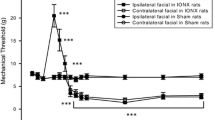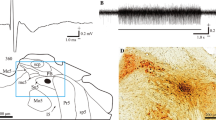Summary
Bilateral trigeminal deafferentation was performed in the rabbit in order to assess the role of orofacial inputs in regulation of the pattern of jaw movements during chewing. After bilateral combined section of the maxillary and inferior alveolar nerves, the animals did not eat food by themselves in the first postoperative week. However, they could chew and swallow when food was inserted into the mouth by an experimenter. The pattern of jaw movements and associated EMG activities of masticatory muscles during chewing were modulated remarkably by deafferentation. These modifications include 1) decrease in the horizontal excursions of the mandible at the power phase, 2) decrease in the maximum gape, 3) insufficient occlusion at the power phase (or increase in the minimum gape), 4) irregular patterns of jaw movements, 5) facilitation of the chewing rate, 6) increase in the number of chewing cycles in a masticatory sequence (the process from acceptance of food to swallowing), and 7) decrease in jaw-closing muscle activities. The findings indicate that deafferentation of the trigeminal sensory branches reduced masticatory force. On the other hand, no significant change was seen in the animals with disruption of cutaneous sensations of the face due to bilateral section of the infraorbital and mental nerves. Intraoral sensations rather than extraoral sensations may thus be important for regulation of masticatory force and jaw movements during chewing. Jaw movements during chewing were also analyzed in the animals with either bilateral ablation of the cortical masticatory area (CMA) or bilateral lesion of the ventral posteromedial nucleus (VPM) of the thalamus in order to examine whether profound effects of trigeminal deafferentation are produced via the transcortical loop. The animals with lesion of either the CMA or VPM demonstrated disturbances in feeding behavior, including the dropping of ingested food from the mouth, elongation of a masticatory process, reduction in the chewing efficiency, etc. However, the pattern of jaw movements during chewing were essentially similar to that in the preoperative period. These results do not necessarily deny a contribution of the CMA to regulation of jaw movements but suggest that the transcortical feedback loop via the CMA and thalamic VPM nucleus would not primarily be responsible for pattern formation of jaw movements during chewing in the rabbit. Probably, the sensory feedback via the transcortical loop may indirectly facilitate activities of the brain stem CPG, which facilitates the chewing rhythm or enables masticatory sequences to be conducted smoothly.
Similar content being viewed by others
References
Ahlgren J (1966) Mechanisms of mastication. Acta Odont Scand 24 Suppl 44: 1–109
Appenteng K, Lund JP, Seguin JJ (1982a) Behavior of cutaneous mechanoreceptors recorded in mandibular division of gasserian ganglion of the rabbit during movements of lower jaw. J Neurophysiol 47: 151–166
Appenteng K, Lund JP, Seguin JJ (1982b) Intraoral mechanoreceptor activity during jaw movement in the anesthetized rabbit. J Neurophysiol 48: 27–37
Bremer F (1923) Physiologie nerveuse de la mastication chez le chat et le lapin. Arch Ital Physiol 21: 308–352
Devor M, Schonfeld D, Seltzer Z, Wall PD (1979) Two modes of cutaneous reinnervation following peripheral nerve injury. J Comp Neurol 185: 211–220
Enomoto S, Schwartz G, Lund JP (1987) The effects of cortical ablation on mastication in the rabbit. Neurosci Lett 82: 162–166
Forssberg H, Grillner S, Rossignol S (1977) Phasic gain control of reflexes from the dorsum of the paw during spinal locomotion. Brain Res 132: 121–139
Frank D (1900) Über die Beziehungen der Grosshirnrinde zum Vorgange der Nahrungsaufnahme. Arch Anat Physiol Abt: 209–216
Freund HJ (1987) Motor deficits after cortical lesions in man. EEG Clin Neurophysiol Suppl 39: 81–82
Goldberger ME (1977) Locomotor recovery after unilateral hindlimb deafferentation in cats. Brain Res 123: 59–74
Goodwin GM, Luschei ES (1974) Effects of destroying spindle afferents from jaw muscles on mastication in monkeys. J Neurophysiol 37: 967–981
Grill H, Norgren R (1978) Neurological tests and behavioural deficits in chronic thalamic and chronic decerebrate rats. Brain Res 143: 299–312
Grillner S, Zangger P (1975) How detailed is the central pattern generator for locomotion. Brain Res 88: 367–371
Grillner S, Zangger P (1984) The effect of dorsal root transection on the efferent motor pattern in the cat's hind limb during locomotion. Acta Physiol Scand 120: 393–405
Hiemae KM (1978) Mammalian mastication: a review of the activity of the jaw muscles and the movements they produce in chewing. In: Butler PM, Josey KA (eds) Development, function and evolution of teeth. Academic Press, London, pp 359–398
Hnik P, Vejsada R, Kasicki S (1981) Reflex and locomotor changes following unilateral deafferentation of rat hindlimb assessed by chronic electromyography. Neuroscience 6: 195–203
Hnik P, Vejsada R, Kasicki S (1982) EMG changes in rat hindlimb muscles following bilateral deafferentation. Pflügers Arch 395: 182–185
Inoue T, Nagashima T, Nakamura T, Morimoto T (1986) Effects of destruction of trigeminal ascending pathways on the jaw movement pattern. J Physiol Soc Jpn 48: 247
Inoue T, Nakamura T, Morimoto T (1984) Alteration of jaw movements after section of trigeminal sensory nerve. J Physiol Soc Jpn 46: 379
Jacquin MF, Zeigler HP (1983) Trigeminal orosensation and ingestive behavior in the rat. Behav Neurosci 97: 62–97
Jones EG (1985) The thalamus. Plenum Press, New York
Jones EG, Schwark HD, Callahan PA (1986) Extent of the ipsilateral representation in the ventral posterior medial nucleus of the monkey thalamus. Exp Brain Res 63: 310–320
Jüch PJW, Van Willigen JD, Broekhuijsen ML, Ballintijn CM (1985) Peripheral influences on the central pattern-rhythm generator for tongue movements in the rat. Arch Oral Biol 30: 415–421
Kaas JH, Merzenich NM, Killackey HP (1983) The reorganization of somatosensory cortex following peripheral nerve damage in adult and developing mammals. Ann Rev Neurosci 6: 325–356
Larson CR, Byrd CE, Garthwaite CR, Luschei ES (1980) Alterations in the pattern of mastication after ablations of the lateral precentral cortex in rhesus macaques. Exp Neurol 70: 638–651
Lavigne G, Kim JS, Valiquette C, Lund JP (1987) Evidence that periodontal pressoreceptors provide positive feedback to jaw closing muscles during mastication. J Neurophysiol 58: 342–358
Lund JP, Lamarre Y (1974) Activity of neurons in the lower precentral cortex during voluntary and rhythmical jaw movements in the monkey. Exp Brain Res 19: 282–299
Lund JP, Sessle BJ (1974) Oral-facial and jaw muscle afferent projections to neurons in cat frontal cortex. Exp Neurol 45: 314–331
Luschei ES, Goodwin GM (1974) Patterns of mandibular movement and jaw muscle activity during mastication in the monkey. J Neurophysiol 37: 954–966
Maddison S, Baldwin BA (1983) Diencephalic neuronal activity during acquisition and ingestion of food in sheep. Brain Res 278: 195–206
Merzenich MM, Kaas JH, Wall JT, Sur M, Nelson RJ (1983) Progression of change following median nerve section in the cortical representation of the hand in areas 3b and 1 in adult owl and squirrel monkeys. Neuroscience 10: 639–665
Miller MG (1981) Trigeminal deafferentation and ingestive behavior in rats. J Comp Physiol Psychol 95: 252–269
Møller E (1974) Action of the muscles of mastication. In: Kawamura Y (ed) Physiology of mastication. Front oral biology, Vol 1. Karger, Basel, pp 121–158
Morimoto T, Inoue T, Kawamura Y, Yamada K (1984) A He-Ne laser position-detector for recording jaw movements: principle of operation and application in animal experiments. J Neurosci Meth 11: 193–198
Morimoto T, Inoue T, Nakamura T, Kawamura Y (1985a) Characteristics of rhythmic jaw movements of the rabbit. Arch Oral Biol 30: 673–677
Morimoto T, Inoue T, Nakamura T, Kawamura Y (1985b) Reevaluation of the cerebral jaw motor area in the rabbit. Neurosci Res Suppl 1: S76
Morimoto T, Inoue T, Masuda Y, Nakamura T, Nagashima T (1987) Autoregulation of masticatory muscle activity by muscle and periodontal receptors. Neurosci Res Suppl 5: S136
Penfield W, Rasmussen T (1950) The cerebral cortex of man. Macmillan, New York
Plesh O, Bishop B, McCall W (1986) Effect of gum hardness on chewing pattern. Exp Neurol 92: 502–512
Robinson PP (1981) Reinnervation of teeth, mucous membrane and skin following section of the inferior alveolar nerve in the cat. Brain Res 220: 241–253
Sawyer CH, Everette JW, Green JD (1954) The rabbit diencephalon in stereotaxic coordinates. J Comp Neurol 101: 801–824
Schaerer P, Legault JV, Zander HA (1966) Mastication under anesthesia. Helv Odont Acta 10: 130–134
Sirisko MA, Sessle BJ (1983) Corticobulbar projection and orofacial and muscle afferent inputs of neurons in primate sensorimotor cerebral cortex. Exp Neurol 82: 716–720
Thexton AJ, Griffiths C, McGarrick J (1980) Evidence for peripheral activation of the trigeminal rhythm generator in the decerebrate rat, obtained by Fourier analysis of conditioning testing curves. Arch Oral Biol 25: 491–494
Thexton AJ, Hiiemae KM, Crompton AW (1980) Food consistency and bite size as regulators of jaw movement during feeding in the cat. J Neurophysiol 44: 456–474
Vanderwolf CH, Kolb B, Cooley RK (1978) Behavior of the rat after removal of the neocortex and hippocampal formation. J Comp Physiol Psychol 92: 156–175
Weijs WA, De Jongh HJ (1977) Strain in mandibular alveolar bone during mastication in the rabbit. Arch Oral Biol 22: 667–675
Weijs WA, Dantuma R (1981) Functional anatomy of the masticatory apparatus in the rabbit (Oryctolagus cuniculus L.) Neth J Zool 31: 99–147
Whishaw IQ, Schallert T, Kolb B (1981) An analysis of feeding and sensorimotor abilities of rats after decortication. J Comp Physiol Psychol 95: 85–103
Zeigler HP (1975) Trigeminal deafferentation and hunger in pigeon (Columbia livia). J Comp Physiol Psychol 89: 827–844
Zeigler HP, Miller P, Levine RR (1975) Trigeminal nerve and eating in pigeon (Columbia livia): neurosensory control of the consumatory responses. J Comp Physiol Psychol 89: 845–858
Zeigler HP, Semba K, Jacquin M (1984) Trigeminal reflexes and ingestive behavior in the rat. Behav Neurosci 98: 1023–1038
Author information
Authors and Affiliations
Rights and permissions
About this article
Cite this article
Inoue, T., Kato, T., Masuda, Y. et al. Modifications of masticatory behavior after trigeminal deafferentation in the rabbit. Exp Brain Res 74, 579–591 (1989). https://doi.org/10.1007/BF00247360
Received:
Accepted:
Issue Date:
DOI: https://doi.org/10.1007/BF00247360




